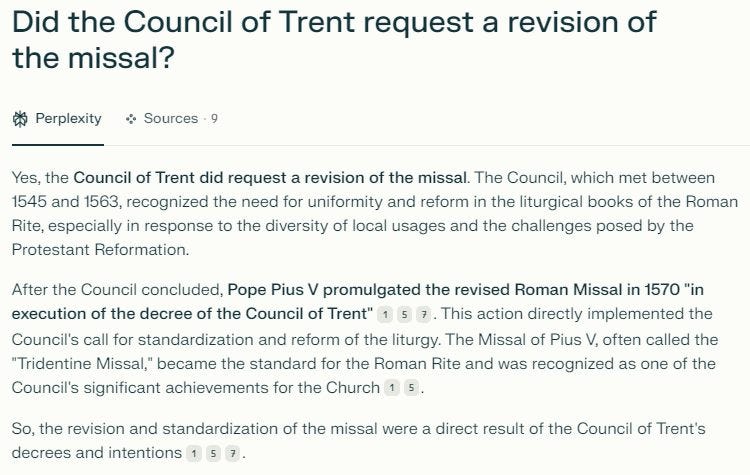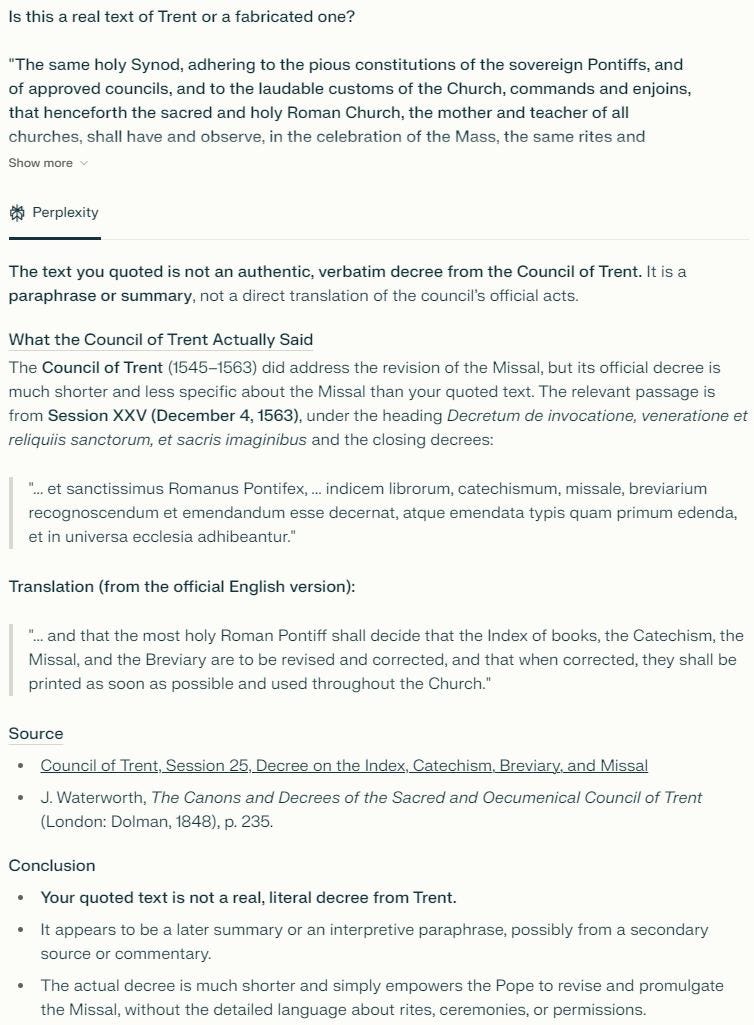Dr. K’s Weekly Roundup, July 11, 2025
More revelations from Montagna; Grillmeister enters; AI idiocy; irrepressible Tradition; obedience to what?; new poetry; good news; and more
Traditionis Custodes continue to crumble
More revelations from Montagna
Diane Montagna is not a journalist you want to tussle with, as the third post at her Substack shows, where she presents additional evidence that discredits the response of Vatican spokesman Matteo Bruni.
Since publishing that story, I have obtained the Vatican protocol number for the CDF final report. Additionally, I have obtained the introduction to its Second Part, which confirms that the overall assessment constituted the official “opinion of the Congregation for the Doctrine of the Faith” to which Pope Francis refers in Traditionis Custodes.
This follows Vatican spokesman Matteo Bruni’s comments last week in which he downplayed the sections of the CDF final report that I published on July 1. He said he would not confirm the sections’ authenticity, that they “presumably” were only a “very partial and incomplete” part of the decision-making process that led to Pope Francis issuing Traditionis Custodes, and that other documents and “confidential reports” went into the Pope’s decision, something that the Vatican had not revealed until now.
But Bruni’s comments raise more questions than they answer.
Diane goes on to show that the summary of the DDF report was, in fact, nothing other than, and nothing less than, a comprehensive summary of all the bishops’ responses. In short: she was right, Bruni was wrong. There’s enough egg on his face to make a table’s worth of omelettes.
Bring on Crickets
Andrea Grillo, the probable ghostwriter of Traditionis Custodes, has weighed in: “Yes, Diane’s evidence is correct: the majority of bishops were in favor of Summorum Pontificum — but the majority of them were simply wrong, and Francis had every right to intervene against their judgment and even to fib about it. The end justifies the means. Nothing is off the table when it comes to ridding the Church of the scourge of traditionalists.”
Well, okay, he didn’t use exactly those words, but if you read his remarks, you’ll see why I summarize him that way. Rorate Caeli has done us the service of translating not only the “money quotes” of Grillo but also a fine article by longtime Vaticanist Sandro Magister as well as the overall assessment from the world’s bishops. You can find all of that in one convenient place.
As for when a pope is allowed to tell lies, the humor blog Eccles is Saved has a perfect answer to that…
Personally, I think Grillo should volunteer to work for this parish:
Vindicated
Nearly four years ago, the reaction of most of us who were paying close attention to the Francis pontificate was that Traditionis Custodes emerged from and represented foul play, bad will, an extermination campaign for opponents of ideologized Catholicism.
And we candidly said so, in an anthology called From Benedict’s Peace to Francis’s War, which included 70 responses by, among others, 5 cardinals (Brandmüller, Burke, Müller, Sarah, Zen) and 4 bishops (Gullickson, Viganò, Mutsaerts, Schneider).
Some at the time complained that the title of our book was too stark, too belligerent, too judgmental.
But our instincts were right. We have been vindicated in every respect and on every level.
Meanwhile, those who continue to defend Francis’s motu proprio should take a long hard look at themselves. To shore up TC’s narrative, they have to join Grillo in taking Francis’s side AGAINST the majority of the world's episcopate. They must throw under the bus Vatican II’s much-touted repristination of collegiality and Francis’s own flagship enterprise of synodality. They have to tell us, to our faces, that the endorsement of Summorum Pontificum by most Catholic bishops and laity was and is wrong.
There can be only one reason for this: they despise tradition and/or traditionalists more than they love anyone or anything else.
And that is not only pathetic, it is abominable.
Meanwhile, the essays in From Benedict’s Peace to Francis’s War have aged well, as they delve into deeper issues of the Church in the modern world, the fallout of the last Council, the liturgical reform’s dark underbelly, and the monumental theological issues at stake in the conflict over the old rite. There’s not a single piece in there that does not merit and repay careful study.
Put not thy trust in AI
Please pardon me for the expression of strong emotions in this section.
AI delivers the most breathtaking B.S. at times.
You know how often people attribute ridiculous things to Trent or to Pius V? Well, I wanted to test Perplexity (an AI module like ChatGPT) with a simple question: “Did the Council of Trent request a revision of the missal?”
The answer it spit out was already only partly correct, I’d say more incorrect than correct:
But then I asked Perplexity to cite a specific text from Trent — and the damn thing FABRICATED a Trenty-sounding quotation that it attributed to Session 25!
Knowing this to be sheer nonsense, I asked it: “Is this a real text of Trent or a fabricated one?” And then it admitted, yes, it’s not a real text:
Like a friggin’ cat playing with a mouse!
Can you imagine the sheer metric tons of nonsense that AI is going to defecate into all levels of discourse in the coming years, as 18-year-old would-be influencers-cum-podcasters jump on various bandwagons and turn to AI for their “research”? They’ll type in a query about Trent, get the nonsense answer, and spew it out, contributing to the general degradation of literacy.
Basically, it’s the Socratic dilemma taken to the nth degree: if you don’t already know what you’re looking for, you won’t know whether you’ve found it or not. As scholarship becomes poorer, the fake narratives (like this one about “Session 25’s text”) will be harder to spot and overcome.
By the way, if you want to know just how conservative Pius V’s reform of the liturgy was, and how in all essentials it preserved a form of the Roman Rite that went back centuries, see Joseph Shaw’s helpful piece.
You can’t suppress tradition
Its enemies will keep trying, but Rob Marco, in “What’s Old Is New,” puts his finger on why they will fail:
In the secular arena, modern progressives destroy everything they touch. They tear down with no real cohesive or thought-out plan of how to rebuild. They tear down the family and religion, statues and monuments, traditional sexual mores. They are impatient, and content to slap up temporary shanties until they can figure out what next thing comes next. Social change can’t happen fast enough. Out with the old, in with the new, until new becomes old and then off to the dump again.
But things get destroyed in the process. Timeless things, priceless things—immortal souls, traditional families, rituals and connections to our past and our ancestors and predecessors.
My prediction goes beyond furniture and housewares, beyond trends and tastes and kitchen renovations. When we hit the modern bottom, when the demons start to tip the scales and become too powerful, when the non-denominational particleboard gets wet and warped, when the trans-everything nonsense hits fever pitch…a few will start to pine for an ancient faith. They will go online to order and meetup; they will seek and they will not find (Jn 7:34) except in those pockets in which it has been preserved as the pearl of great price that it is, a soft glow of candles in stained glass windows in the darkness, shards of light reflecting off a gold monstrance in the sanctuary, the quiet ancient chant of plainsong beckoning behind thick solid wood doors.
It will be exotic and intimidating, ethereal and forbidden, austere and arduous, foreign and yet completely familiar. The Faith of our fathers, the Faith handed down, the Faith communion that takes place in real time…it will be both old, and new.
Similar to this is Gavin Ashenden’s article “The Tridentine Mass as an antidote to informality,” on why it makes sense that the TLM would be attractive to youth precisely at this juncture in history.
The most misunderstood topic in the Church
Sophia Institute Press is having a gigantic sale, and I notice they have my tract True Obedience in the Church for only $5 (regular price $15). Now’s your chance to stock up on copies to hand out freely.
This is a book that every priest and seminarian should read (and indeed, quite a few of them have already, as I know from the sales department and from much private correspondence!). But if there is any issue badly misunderstood today, it’s this one, for sure.
Obedience to those who would tear down the Church or undermine the faith of Catholics is a false, harmful, destructive vice, not a glowing virtue. Abusers, revolutionaries, and manipulators of all kinds rely on blind obedience as their key tool. Without it, they would never be able to succeed. Using authoritative sources, this tract explains both what the virtue is and how to recognize when conscientious resistance is allowed or required.
Listen, for example, to a priest at Little Flower Basilica in San Antonio announcing Archbishop Gustavo Garcia-Siller’s new policy that Holy Communion will not be distributed at the communion rail, as had been the custom before, but in a queue outside the rail (40 second clip here). Evidently he hasn’t read True Obedience or he wouldn’t make the false argument he makes, equating the will of the archbishop with “the Church.” This is the same archbishop who has persecuted Sanctus Ranch.
Until the false obedience goes away for good, the crisis in the Church will linger on and on, like a final illness that never lets go. Health will return when we adhere to truth and tradition with a clear conscience, putting them ahead of any man, whoever he may be.
Thus, when Tate Hilgefort argues that “Parish Priests Are the Cure to the Crisis,” I quite agree. But the missing ingredient in his analysis is the TLM. (Perhaps you could say, charitably, that the author was thinking it but decided not to say it…) When the TLM is in place, at the center, the other things Hilgefort advocates are much easier to do, because there’s a center of gravity that elevates and inspires seriousness. Without it, there will always be various contradictions that just don’t make sense and undermine the general effort.
Indeed, that’s what I explain in my last book, Close the Workshop: Why the Old Mass Isn’t Broken and the New Mass Can’t Be Fixed. It’s my absolute farewell to the irredeemable liturgical reform. I dare anyone to read this book and come away still thinking the ROTR [Reform of the Reform] is viable.
The latest from Os Justi Press
Our first book of poetry
A few tastes from William Dunn’s Songs of Desert Winds:
And then was our world awoken
To desert stars and Heaven’s clime,
The image strewn, through centuries broken,
Recollected in its Paradigm
Let all be still beside that stream
Where only little children dream…
Let all be still beside that Breath
Which blows across both life and death
All the fled and fleeting strands of time
Weave together in a greater rhyme
Dunn’s finely-honed verse examines modernity under a rigorous lens while simultaneously contemplating the beauty of the transcendent.
In the words of Fr. John Saward: “William Dunn writes with a simplicity reminiscent of his masters, the English Romantics and the agrarian poets of America. Like Wordsworth, he lives in uninterrupted dialogue with his childhood; as he sees it, the child is not only the father of the man, but the man’s best teacher, if only he would listen. Like Robert Frost and Wendell Berry, Dunn is a poet who finds a universe of meaning in the particularities of a familiar and beloved landscape.... And if Dunn knows that the world is wonderful because it has been created by God, he recognizes the still greater wonder of its re-creation by God’s Son, incarnate of the Virgin Mary.”
Literary critic Joseph Pearce says: “I have known and admired William Dunn’s poetry for many years. He is both a true mystic and a true philosopher.... Reading his verse, we are taken into God’s mystical Presence but also into the desolation of his absence. Few poets are able to take such a penetrative delve and dive into darkness, without losing sight of redeeming light.”
Find Songs of Desert Winds at the publisher or at Amazon.
Spanish edition of Sire’s Phoenix from the Ashes
Me complace anunciar la publicación, por parte de Os Justi Press, de la edición en español de uno de los mejores libros jamás escritos sobre la historia de la Iglesia moderna: El Fénix Renaciente: Construcción, destrucción y restauración de la Tradición católica, de H. J. A. Sire.
Una breve descripción de este espléndido libro:
El Fénix Renaciente es una completa revisión del estado de la Iglesia católica desde el Concilio Vaticano Segundo, último período de una serie de crisis morales e intelectuales en que la Iglesia ha caído a lo largo de su historia. El capítulo sobre el Concilio describe detalladamente cómo éste fue desviado por el papa Pablo VI al permitir que los liberales europeos asumieran su control exclusivo. Se dedica también un análisis cuidadoso a la “reforma” litúrgica, encargada por el mismo papa a un grupo de radicales, cuya obra carcomió la herencia espiritual y devocional de los fieles. La pérdida de una enseñanza ortodoxa y la desorientación que siguió a estos cambios produjeron una grave crisis, tanto en el clero como en el laicado; pero el movimiento de regreso a la tradición, visible en la actualidad, promete un renacer de la plenitud de la vida católica en la Iglesia. Los lectores católicos tienen ahora una narración completa y eminentemente accesible de los graves cambios ocurridos en la Iglesia moderna, hecha por un magistral historiador que sabe distinguir lo que en esta crisis es único de lo que comparte con otras conmociones del pasado.
Disponible en formato de tapa blanda, tapa dura o libro electrónico en cualquier sitio web de Amazon—por ejemplo, en España, en Estados Unidos, en México.
Ne plus ultra
Dominic Cassella has a superb review of the anthology Ultramontanism and Tradition over at The Catholic Thing: “Understanding the Office of Peter.”
Good News
Coming to terms with Moms and Dads
J.C. Miller writes: “As homeschooling continues to grow, and homeschoolers have higher rates of vocations and faith retention, dioceses and churches that embrace homeschoolers could find themselves growing—or at least surviving—while those who fight and banish homeschoolers find themselves dying.”
John Senior’s moment has come?
Reading Sean Fitzpatrick’s article in honor of the great Kansas educator, I agree that the time has come for the “John Senior” model of education to take pride of place. In its engagement with memory and imagination, its use of the outdoors and handwork, its cultivation of arts and crafts, and its adherence to traditional Catholicism, it is better than a merely conservative and confined-to-the-classroom type of education. And I think it’s relatively easy to follow Seniorite principles even in homeschooling.
Low-tech for health
The key is to keep life simple and low-tech. That is the “secret ingredient” to a successful education. Thus, I recommend, first, the interview I did with Rob Marco on the topic of smartphones, published over at Edward Pentin’s Substack:
Then, I’d recommend listening to Clare Morell’s conversation with R. R. Reno about her recent book, The Tech Exit: A Practical Guide to Freeing Kids and Teens from Smartphones.
Robert Keim’s Latin course
I don’t know if this makes me some sort of barbarian, but I’ll take the Vulgate Gospels and a chanted Latin introit over Horace’s Odes on any day of the week, and in any week of my life. Fortunately—and this point is not sufficiently emphasized in the Catholic world—learning enough Latin to understand and enjoy certain portions of the Mass (and the divine office) is easier than completing a typical sequence of Latin courses, and far easier than gaining the proficiency needed to read classical literature.
Robert’s crash-course in liturgical Latin has begun; I urge you all to check it out and consider enrolling yourself and/or your children or altar servers or choir members, etc.
Two touching moments
Hailing from Kansas City, a new priest for the Institute of Christ the King meets his mother afterwards. In a world full of bad news, it is good to remind ourselves that the Lord is ever at work, in quiet and beautiful ways.
Tremendous conversion story
Ross Arlen Tieken’s gripping story of conversion is highly recommended, especially for those who fell away (or were tempted to fall away) from Christianity due to its being presented as a boring, texty, cartoonish pseudo-religion. An excerpt:
It finally dawned on me that Catholicism alone had kept the old magic alive. The Eucharist, not as symbol—but as actual Body and Blood. The meeting place of heaven and earth, the world of spirit and the world of flesh. The sacrifice in the temple. The blood spilled for the salvation of the world. And from this touching point of heaven and Earth, the greyness of reality washed away; there was a new root from the stem of Jesse. Christ was the only living thing in the Universe and we are all only alive if we graft ourselves to His Body. His Blood. I remember that day, when it came together. I remember the ache in my chest and the slaver in my mouth. I was hungry for the Eucharist.
Wherever His Body and Blood are, that is the only place that I can be. Any diminution of the Eucharist is the death of the world. The Eucharist is everything. If it is true, nothing else matters, and the only way we can approach this tremendous mystery is to surround it with guards and reverence, trembling and mystery. The Eucharist is the key that unlocks every door, the one paradox that untangles every paradox. The one miracle which makes all things miraculous. It is the Old Magic.
Everything made sense, then. The prayers that invoked saints and angels. The paintings, the bells, the processions, the incense and icons. Mary. The sacraments. The whole blooming, teeming, sprawling garden of Christendom came into sharp focus. The Middle Ages wasn’t a “religious age”. No. Christendom was a Sacramental Reality. I couldn’t ignore my heart any longer—I had to become Catholic.
If you love Sebastian Morello, you will love Tieken’s Substack, El Antiguo. (Tieken also, by the way, posted a long but beautiful meditation on what it means to be an American patriot, with all the paradoxes that that involves for a serious Catholic.)
New Benedictine monastery
Remember the news about the founding of a traditional Benedictine monastery in Sweden—the first since the Reformation? Well, there’s good news: the founder was able to win a competitive bid on a perfect property for the community. You can read the July 5 update by going to this page and scrolling down just a bit. Please consider sending some of your tithing money in this direction. I can vouch for this monk and his project, and I’m supporting it too.
Chant workshop in Nashville
This place isn’t just for country music. The Church of the Assumption in Nashville is hosting a Gregorian chant workshop the weekend of September 26. Br. Mark Bachmann, choirmaster of the abbey of Clear Creek, will be the instructor. You can register here.
New Substack very much worth checking out
I’d like to recommend a new kid on the block. Not that the persons involved are in any way new to their job, they’re simply new to Substack: Katherine Bennett, Dr Gavin Ashenden, and Mark Lambert, of Catholic Unscripted.
Lastly, if you haven’t already, please check out Robert Lazu Kmita’s rich and diverse Substack, and consider subscribing to it in support of his superb scholarship.
Other Recommended Articles
Robert Lazu Kmita discusses “The Fantastic Secret of Tolkien’s Fairy-Tales.”
I agree with Shawn—the Italo-Byzantine Church of Santa Maria dell’Ammiraglio is spectacular. It was the highlight of my visit to Palermo last February. The gallery here gives you a taste of the quality of Byzantine iconography to be found in parts of the West.
My article this week at NLM is refresher course—particularly helpful for clergy and servers—on genuflections at communion time in the TLM.
Lovers of St. Thérèse, take note: “Those pilgrims who visit the Carmel in Lisieux are treated to a wonderful little museum at the entrance. Here on display can be seen a set of vestments made by St. Thérèse while she was a sister in the convent. It is a Low Mass Requiem set, in typical French style from that period. The material used was taken from a dress that belonged to her mother, Zélie Martin, who passed away in 1877 when Thérèse was only four-a-half years old.”
Aaron Pattee asks “What is Beauty?” and speculates on why older artworks attract much more attention and favor from the public than modern(ist) ones do.
Those interested in law, legality, legal theory, take note of a new publication by Carlos Casanova, who introduces and presents a fresh translation of Radbruch’s “Laws That Are Not Right and Right Above the Laws.”
Speaking of conversion stories, what a beautiful (and very entertaining) witness to the Faith and to the power of the Latin Mass Fr. Richard Cipolla has given in his autobiographical sketch, “Lux in Tenebris.”
Thanks for reading and God bless you!
Don’t wish to take out a paid subscription just now? I understand! How about a one-time tip?














I’m 75, living in rural Victoria (Australia) married, a father of 5, grandfather of 11, retired and living a quiet life. Although we have practically no chance to attend the TLM your weekly summary fills me with hope and a sense of excitement for a future that I’m not likely to live to see. With all my heart I thank you!
Favor, please? Dr K, if you could please help spread the word about GiveSendGo, as a Christian--and also better--alternative to GoFundMe, which as you probably remember illegally withheld the donations from the Canadian Freedom Convoy (the truckers demonstrating in 2022)?
[Still angry enough about that to pass on many worthy causes because they come through GFM instead of GSG.]